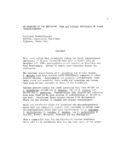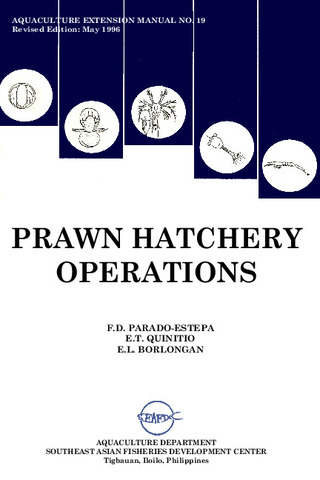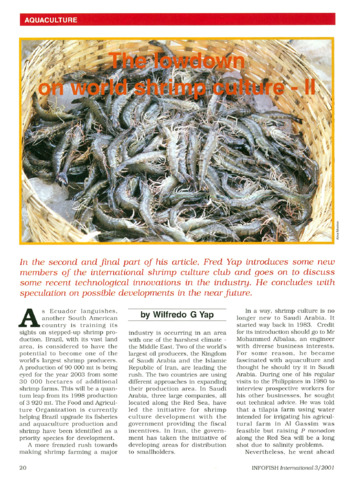Use of the golden apple snail, cassava, and maize as feeds for the tiger shrimp, Penaeus monodon, in ponds
- Global styles
- MLA
- Vancouver
- Elsevier - Harvard
- APA
- Help

閲覧/開く
日付
1995Page views
1,951ASFA keyword
AGROVOC keyword
Taxonomic term
Metadata
アイテムの詳細レコードを表示する
Share
抄録
Penaeus monodon stocked in ponds at 8000/ha were fed four types of farm-made feeds starting on day 16 of a 4-month culture period. The feeds were golden apple snail alone or in combination with cooked cassava or maize, or maize only. Mixed feeds resulted in significantly higher production, growth, and better size-frequency distribution of shrimp. Survival (88–99%) was not significantly different among the treatments. Maize alone or snails alone were inadequate. Presumably, the high amount of carbohydrate in cassava (92%) or maize (87%) provided the needed energy, and the high protein content of golden snail (54%) was available for growth. The fatty acid profile of the golden snail shows that it is a good source of 18:2n-6, 18:3n-3, and 20:5n-3 which are essential fatty acids for P. monodon. The golden snail, with an essential amino acid index (EAAI) of 0.84, is a useful alternative source of protein for tiger shrimp. Feeding shrimps with golden snails and cassava yielded the highest net income (P48797/ha-crop) and return on investment (ROI = 206%) better than feeding with maize alone (net income = P23190/ha-crop; ROI = 120%), an industry practice. If shrimp farmers use golden snails as direct feed or as a feed ingredient, the problem of snail infestation in ricefields may be reduced. Snails will no longer be viewed as pests but rather as a resource which has economic value.
Suggested Citation
Bombeo-Tuburan, I., Fukumoto, S., & Rodriguez, E. M. (1995). Use of the golden apple snail, cassava, and maize as feeds for the tiger shrimp, Penaeus monodon, in ponds. Aquaculture , 131(1-2), 91-100. https://doi.org/10.1016/0044-8486(94)00329-M
Type
ArticleISSN
0044-8486Collections
- Journal Articles [1258]
Related items
Showing items related by title, author, creator and subject.
-
An overview of the nutrition, feed and feeding techniques of prawn penaeid/shrimps
Piedad-Pascual, Felicitas (Philippine Council for Aquatic and Marine Research and Development, 1989)This paper echoes what transpired during the first International Conference of Penaeid Prawns/Shrimps held in Iloilo City in December 4-7, 1984, particularly on the Nutrition nd Feed Development. Around 25 papers were ... -
Series: Aquaculture extension manual; No. 19
Prawn hatchery operations
Parado-Estepa, Fe D.; Quinitio, Emilia T. ; Borlongan, Emeterio L. (Aquaculture Department, Southeast Asian Fisheries Development Center, 1996-05)
The manual, an updated version of the 1984 SEAFDEC/AQD manual, presents the underlying principles and step-by-step instructions of prawn larval and post-larval rearing. The techniques described are not only applicable to ...
; Borlongan, Emeterio L. (Aquaculture Department, Southeast Asian Fisheries Development Center, 1996-05)
The manual, an updated version of the 1984 SEAFDEC/AQD manual, presents the underlying principles and step-by-step instructions of prawn larval and post-larval rearing. The techniques described are not only applicable to ... -
The lowdown on world shrimp culture - II
Yap, Wilfredo G. (INFOFISH, 2001)This paper introduces some new members of the international shrimp culture club and goes on to discuss some recent technological innovations in the industry, particularly the polyculture of tilapia (mainly Oreochromis ...





